Lakes
I love to fish worms on a single barb-less hook without any weight. I hook a lively worm Texas style in the head with the point buried so it’s both weed-less and snag-less. I use a light line with 4# which is ideal and cast it with a long UL rod. I allow the worm to struggle as it sinks. When it on the bottom I retrieve it in a stop-and-go manner. I pull it up with the rod tip and stop. My pulls are from six inches to two or three
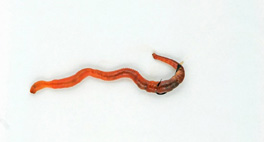
feet. I drop the rod tip back down again. This is the most effective bait fishing method I’ve ever encountered; with it I have taken huge trout and bass.
This method attracts fish in many ways. The wiggling, sinking worm after the cast attracts fish in two ways. The light splashdown causes the fish to look over, and when the worm wriggles as it sinks, it’s just too much for a foraging fish to resist. If this doesn’t work, the worm is now wriggling as the stop-and-go retrieve passes closely over the bottom. Such bottom movement causes strikes. So if there are fish foraging, this method is deadly for them.
I watch the line for any unnatural twitches or movements, especially on the fall. I quickly set the hook lightly when the line pulls. If I miss, I drop the rod top back down to see if the fish returns. Sometimes a whole night crawler or worm is a big offering and the fish takes only part of it and then returns. The hook portion of the bait must be in the fish’s mouth.
Sometimes I break a large night crawler into two pieces. I hook the unbroken end and let the broken end trail scent.
My favorite set up is a steelhead noodle rod which is 9 foot in ultra light action. It can cast a light worm quite a distance with a #4 test monofilament. Its length allows for great stop-and-go action. But I’ve also used 6 ½’ to 7’ rods with success.
My next favorite still water worm set up was my favorite back in the early 1960’s. I have never seen anyone today using it, but now I believe it works better today than it did back then.
I fill a cast-a-bubble full of water. I slip my line through it and I’ve placed a bead and tied on a small barrel swivel. Next I use a 3’ or 4’ leader and a single, barb-less, light wire hook. The garden worm or half night crawler is hooked Texas style by its head so that it travels weed-less on the retrieve. The slip bobber
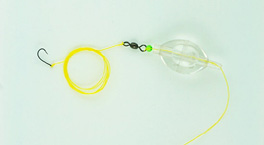
allows you to freely feel any light bites.
I cast it out and count down its slow sink to the bottom. The cast-a-bubble is slightly denser than water, so it is a slow sinker. Although the water-filled cast-a-bubble is heavy and casts far, it makes a big splash which is like a surface-feeding game fish. Its slow descent allows the worm to flutter and wiggle. Once it is on the bottom, I let it set for about 30 seconds and pull it with the rod about three feet. I can pull it either upright or sideways. The upright lift pulls the bait upwards, whereas the sideways pull keeps the worm at the same level. Once I pull, I let it settle back down again on a light pressure-taut line. I can feel the slightest bite with this rig. When I’m hit, I’ll point the rod tip towards the fish and wait till the line runs, then set the hook. I set the hook lightly at first for the fish may not have the hook portion of the worm in its mouth. I drop the rod back down and look for a follow-up strike if I miss the first one. These methods swim the worm in a stop-and-go motion all along the bottom. The water-filled bobber allows for the retrieve to suspend just over the bottom. The trailing worm is stretched out and wiggles throughout the retrieve. The natural worm scent trailing is effective. If you fish with delicate pulls, snags are somewhat uncommon. Use a lighter test leader so you don’t lose the cast-a-bubble.
The big advantage is that you cover a lot of water with this method. You don’t have to wait for a fish to come along. You take the worm to the fish. Again, the splash down, initial sink, and stop-and-go retrieve is highly effective.
When fishing with youngsters, you will find that they love bobber fishing. It gives them a visual object that’s easy to see. The bobber goes sideways or under when there is a strike. Another advantage is that the worm is suspended when you want it. For surface feeders, I like about three feet of distance between bobber and worm. For bottom feeders, I want the worm to be a foot or two above the bottom. Here a
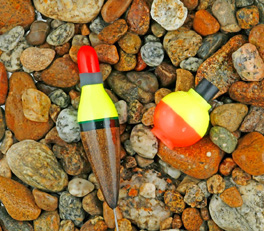
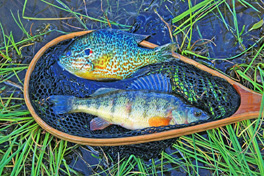
slip bobber can be used with the bobber stop set for this ideal depth. You cast it out and the worm will sink to just above the bottom and the stop on the line keeps the worm suspended. Here foraging fish can easily find your bait.
I prefer to set the hook as soon as the bobber travels sideways. This means the fish has taken it and is swimming away. Sometimes the bobber just bobs slightly and usually this means the fish is nibbling on a piece of the worm and it’s most likely not the piece with your hook. Threading the worm along the line places the hook at the worm’s end. Then a fast strike may cause the hook to slide into its mouth. I thread the worm when the strikes are finicky ones. My first strike is a light one in which I am feeling to see if there is a fish on. I next strike harder to safely embed the hook. Light wire, sharp, barb-less hooks stick the point even during light strikes. This is an advantage and I’m convinced that I hook far more fish with barb-less hooks than barbed ones. Plus the catch and release is simple with the barb-less hook. No need to pull and twist which can cause trauma to the fish’s oral cavity.
Worms fished right on the bottom catch fish, but not as many because they can be hidden inside the weed beds. It’s best to suspend them above these weeds. This was accomplished back in the 1950’s by adding a miniature marshmallow. This adds color and a sweet taste. Yes, fish have a sweet tooth. Another way is to inject air into the worm so it floats. The floating worm is effective.
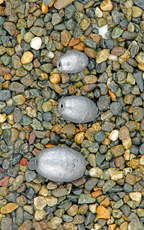
Slip sinkers are preferred over fixed sinkers. These allow for enhanced feel of the strike. If the fish must drag a ½ ounce weight first, it may reject it without you feeling the strike. Oval sinkers with a center hole are effective. Run your line through; attach a bead; and tie on a small, barrel swivel. Tie the leader with the hook to the other end of the swivel. This can be stop-and-go retrieved, but the heavy sinker doesn’t suspend like a cast-a-bubble to the sinker.
Hooking a night crawler or a drop shot rig is also effective. Here a dropper is several feet away from the sinker which is on the bottom. It can be retrieved and swam just over the bottom. I use a split-shot sinker

which can pull free in a snag. Lead-free sinkers are safer for the environment and should be substituted for the lead.
Threading worms evenly along the line not only keeps them in place, but makes a larger silhouette which the fish can easily spot. During the retrieve, the crawler moves like a leech. Many times it’s mistaken for a leech. Worm threaders are useful but one worm can be arduous to thread.
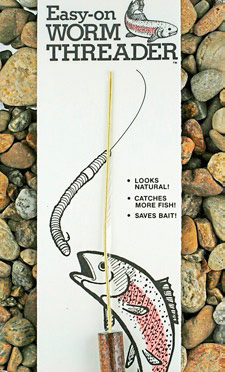
Night crawler and garden worms are effective baits that work nearly everywhere all during the season. I’ve caught small bluegills to giant steelhead on worms. My biggest largemouth bass was taken on the first worm method presented. Worm fishing is a great way to introduce fishing to youngsters.
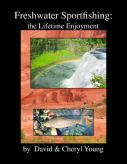
© 2026 The Gale Group, Inc. All rights reserved.
© 2026 Perigee Learning LLC. All rights reserved.
LoveTheOutdoors.com is owned and operated by Advameg, Inc. © 2026 Advameg, Inc.
Camping Adventures • Dutch Oven Cooking • Sports Knots
Fly Tying • Freshwater Fishing • Fly Fishing

